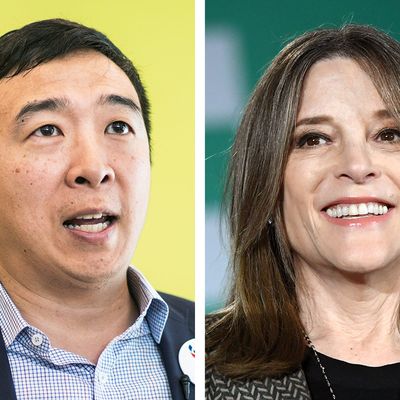
Former presidential candidate Marianne Williamson’s announcement that she’s “lending” her support to surviving candidate Andrew Yang in Iowa (though not yet endorsing him) drew some chuckles from those wondering what support she had to share (other than in Fairfield, home of the transcendental meditation–focused Maharishi University and a Williamson stronghold). In the most recent Iowa poll for CNN, the Des Moines Register, and Mediacom (taken right before she laid off her campaign staff), Williamson registered zero support and an insanely poor 8/51 favorable/unfavorable ratio among likely caucusgoers.
But even if the best-selling author and apostle of a politics of love has few tangible assets to hand over to Yang, her gesture is a reminder of how important candidate coalitions can be in Iowa, particularly on Caucus Night itself, when rivals can become friends and allies very quickly.
The way the process works is simple if time-consuming: At each precinct site, attendees are divided into preference groups for the various candidates. Depending on the number of state delegate equivalents (a highly technical term that’s congruent with county delegates) a precinct has, there will be a “viability threshold” for securing any delegates at all; except for the really small precincts, that threshold is going to be 15 percent of total attendance. A second division of caucusgoers is held in which members of nonviable groups can “realign” (or if they wish, go home) after a brief period of electioneering in which viable candidate groups implore them to join.
In a race like this year’s with four candidates clustered at the top in Iowa, and with support distributed pretty evenly around the state, you could have third-place, fourth-place, and perhaps fifth-place candidates near the viability threshold in a lot of precincts. So second-choice preferences can matter a lot, and beyond that, campaigns may guide their nonviable groups to move in a particular direction based on their overall strategy. Let’s say for the sake of argument that the Buttigieg campaign is worried about the Klobuchar campaign squeezing it out for fourth place statewide and a “ticket out of Iowa.” It might suggest its supporters go elsewhere in a precinct realignment.
In the past there have even been formal statewide alliances in which campaigns agree to support each other’s candidates in situations where they fail to reach viability. This happened in 2004, when the Iowa campaigns of John Edwards and Dennis Kucinich cut this sort of deal, and it probably helped Edwards achieve a second-place finish.
There’s no word of anything like that happening so far, but without question, tactical maneuvering — with or without statewide coordination — is going to be a big deal on Caucus Night if the race stays as close as it’s been. The Yang Gang may be competing for viability here and there, and if they are close, they will need all the help they can get, even from the scattered devotees of Marianne Williamson.






























